If I count correctly, this RunCam 2 will be the 7th quadcopter camera that I’m been reviewing. Honestly, I haven’t yet found a camera that offers brilliant quality at an affordable price. Who knows, being the lucky 7th, this RunCam 2 will be the best camera for me :)
It would be nice to make a side-by-side comparison between this RunCam 2 and the GoPro Hero 4 Black, even though I know these two are from different leagues and are mainly designed for other applications. Meanwhile, the RunCam cameras are designed for RC enthusiasts, and the GoPro products are for extreme sports fanatics.
A few months ago, I received the RunCamHD for review, which proved to be a nice lightweight FPV camera. I had only a few complaints regarding this older model which mostly seems to be remedied by the upgraded model.
I plan to test this RunCam 2 camera with my new Runner 250 Advance racing quadcopter because I think they will make a perfect pair. I am very frustrated because of the bad weather that lasts for three weeks now so I didn’t have the opportunity to flow it outside yet.
RunCam 2 review
First of all. I must thank Min from RunCam, who offered me this camera for review. The box was marked as a “sample” and it is possible that the final version of the product will have some minor changes. BTW, the camera was listed for order only starting yesterday (Dec 09, 2015).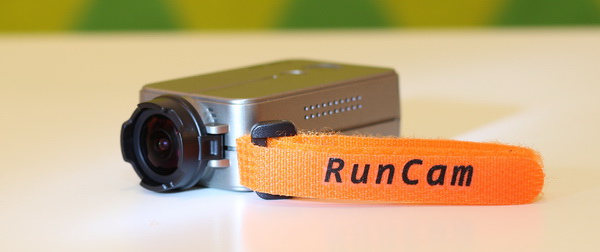
I received the silver version of the camera but unlike its predecessor, the RunCam 2 is also available in crispy orange color which is nice because it makes it more visible and easy to find when you accidentally lose it in the flight field.
RunCam 2: First impressions
The camera comes in the same simple but stylish carton box as the one we are accustomed to from RunCam. Fortunately, the package contains much more accessories than the previous model. The lack of a lens cap was the only negative thing for me because that tiny, inexpensive piece of plastic can protect the lens from scratches during transportation.
Included with the RunCam 2 camera
- 850 mAh battery;
- Two pieces of velcro bands;
- Two pieces of 3M tapes;
- 1/4″ tripod adapter;
- GoPro adapter;
- Camera base;
- RCA AV-Out cable;
- Micro USB to AV-out FPV cable;
- RunCam 2 user manual.
At first sight, the RunCam 2 has a very good build quality, and it looks extremely nice, especially when is turned ON, thanks to the bright status LEDs. Having a size of 66 mm x 38 mm, it is slightly bigger and 8 grams heavier than its predecessor. Unfortunately, the camera’s base (mount) is not interchangeable because it has a different footprint than the earlier model.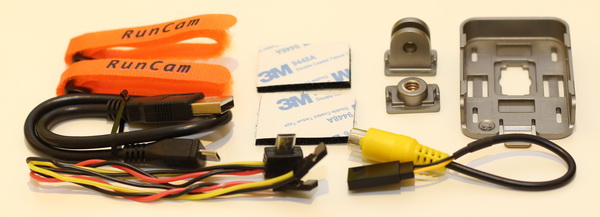
The recorded videos and captured photos are stored on a micro SD memory card, which can be up to 64 GB. I recommend to use class 10 type cards to handle the average 34 Mb/s video bit rate. The micro SD slot is behind the battery compartment door, this way, the memory card is protected from sliding out in case of crash lands.
On the top of the camera, there are two buttons and two status LEDs. The camera can be turned ON/OFF by pressing for 3 seconds the power/shutter button. By long pressing the “WiFi” button, the camera can be switched between video, photo, and settings mode.
There is a cool circular LED around the “Power” button, which is glowing in different colors according to the status of the camera:
- Blue – always ON when the camera is in video mode and blinks when recording;
- Green – always ON when the camera is in photo mode and blinks every shot;
- Red – when the battery is charging.

RunCam 2 has a nice OSD menu, which allows you to fine-tune the camera settings and set the desired video formats.
This camera is designed mainly to be used on remote-controlled aircraft, but thanks to the loop recording and auto start recording features, the RunCam 2 can be used as well as a dash cam in your car. BTW, it can also take photos in JPEG format with 2304 x 1728 pixels.
RunCam 2 camera: Features and specs
- Small form factor;
- RF shielding;
- 4 MP image sensor;
- Video formats: 1440 p@30 fps (4/3), 1080 p@60 fps (16/9), 1080 p@30 fps, 720 p@120 fps, 720 p@60 fps and VGA@240 fps;
- Photo resolution: 2304 x 1728;
- Integrated lens hood for protection;
- 120-degree field of view (FOV);
- Video-Out for first-person view flights;
- Excellent video out latency (60 ms at 1080 p and 40 ms at 720 p);
- Removable 850 mAh battery;
- Wide range of input voltage;
- G-sensor for auto 180-degree rotation;
- Loop recording and auto start recording when is powered ON;
- Webcam mode;
- Digital image stabilization (IS);
- WIFI connection;
- iOS and Android APP;
- Size: 66 mm(L) x 38 mm(W) x 21 mm(h);
- Camera weight: 49 g with battery.

RunCam 2 review: Battery life
Instead of a built-in battery, the RunCam HD2 comes with a replaceable 850 mMa battery, so when needed, you can always have a charged spare one ready to use. A fully charged battery has up to 90 minutes of operation time (greatly depending on the selected video format). The battery can be recharged using the included micro USB cable via any USB charger or computer USB port.
The camera can also be powered from the aircraft’s main battery to an AV-out cable through the included micro USB. It accepts a wide range of input voltage can be fed from 5 V to 17 V (2-4 s LI-PO batteries).
RunCam 2: Android mobile App for configuraiton
Through the RunCam 2 APP, the camera can be remotely controlled and configured. Using this APP, you can set the video format, and enable the slow motion and time-lapse mode. To secure the camera from unauthorized access, both the WiFi name and password can be changed. In case you forget your password, it is displayed via AV-out at the time you enable the WiFi connection.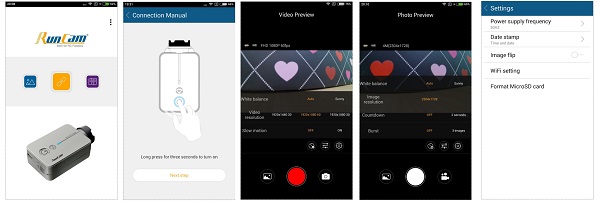
RunCam 2: Performance and image quality
The RunCam 2 can have many video formats, but the most interesting one is 1920 x 1080 with 60 fps (16:9 aspect ratio). The 1920 x 1440 @ 30 fps video format is for those who prefer the 4:3 aspect ratio.
Usually, I go to work on foot, and I decided to do a quick test of the camera this morning. Frankly, I was a bit disappointed. In low light conditions, both videos and images were almost unusable. Definitely, for night FPV races, I will need a dedicated TVL camera like the PZ0420M. On the way home, the camera behaved much better in good light conditions, offering very sharp videos.
To test the advertised 60 ms video out latency (at 1080 p), I performed a quick test using a tablet with a stopwatch APP and an FPV screen. After 60 seconds, I got about a 65-millisecond delay between the real-time and FPV images. My testing “tools” are probably inaccurate, so the 60 ms looks plausible. Not bad, but I will probably keep the 800 TVL FPV camera on my Runner 250 and add this RunCam2 as an additional camcorder.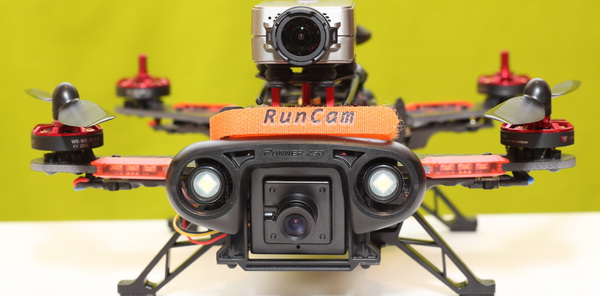
The RC2 has an electronic (digital IS) image stabilization system, which probably can’t beat optical image stabilization; anyway, I will make some tests with and without it to see if there are any noticeable differences.
Pricing and availability
For those who need an ultralight camera with 1080p@60 fps video resolution, this RunCam 2 looks to be a great choice. Everyone interested in buying this cam should know it can be ordered directly from the manufacturer’s website here.
RunCam 2 camera: Unboxing, OSD menu, Android APP, Latency test video
Updates on 06 June 2016
The manufacturer announced the RunCam Firmware V2.0 with the following updates:
- File protection feature (Under loop recording, it can save the recorded file if the camera loses power/battery runs out);
- Optimized image quality;
- No more black bars on TV-OUT;
- OSD menu modified into three-level;
- REC blinking icon replaced with a red point;
- G-sensor sensitivity optimized;
- WiFi standby time was modified to 3 minutes.

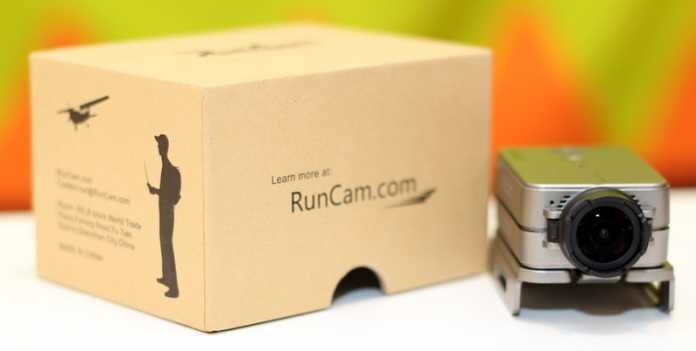

Worth to upgrade from rc1 to runcam 2?
I’m looking for a camera for my motorbike – I’m guessing that quadcopters probably have similar requirements when it comes to video quality and will be working in similar conditions (i.e. must give a clear picture at relatively high speeds)?
Mine wont connect to my phone or tablet, nexus 5, and asus tablet. I’ve tried all the apps.
Any ideas?
Hi, thanks for review.
Could you point me to tutorial on how setup to work with a 5.8G fpv system (how connect runcam to VTX and so on)
Thank you
Hi and welcome on FirstQuadcopter.com!
The wiring is very simple.
As the RunCam2 is self-powered you can leave aside the red&black wires.
The yellow wire (from the micro USB cable) is the AV-out (CVBS) and you have to connect to the TX module’s “Video IN” pin. The black wire is GND and you have to interconnect it the TX’s ground.
Good luck!
So, I gather if you don’t have a smart phone running Android OS you have no other means of setting up the Runcam2?
Just updated to the new RUNCAM2 V1.3 Firmware.
Some of the new features:
– Better sound recording;
– Fix the bug of invalid G-sensor after rebooting the RC2;
– Adding reset to factory settings option (in standby mode, press quickly 3 times the power button);
– Loop recording is off by default.
after the update the version information should be: Jan 8 2016 Ver. 1.3
As a recording HD cam for FPV quads,would you say it’s better than Mobius, Yi, Foxeer and GoPro H 4?
HD cams are not good for racing quads as fpv camera, all of them have bad latency, I think.
I think there is NO action camera that can beat the GoPro Hereo4 :)
When weight is critical the RunCam2 seems to be a good compromise. It has very good video quality, high frame rate and decent latency on FPV out.
Later I will upload some test videos recorded with the RC2.